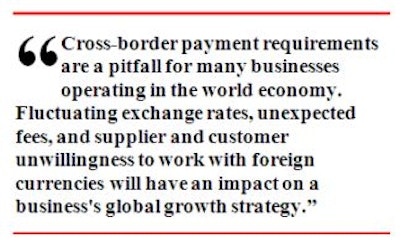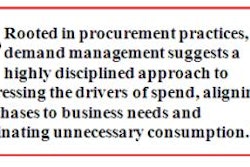
March 9, 2009 — As evidenced by today's environment, international business has created a global economy. Suppliers, customers, partners and employees can be found all around the world. It's not uncommon to find a firm with headquarters in Europe, manufacturing operations in Asia and South America, sales channels in North America and resources in multiple regions.
The business model paradigm has shifted from being "international" with sales and operations in a few foreign countries to being "global" with businesses managing core structural operations from multiple places around the world with little regard to borders. If only that was the case with cross-border payments.
Cross-border payments and the need to conduct foreign exchange is an integral part of doing business today, with approximately $3.2 trillion changing hands daily. Foreign exchange risk affects any business with exposure to international payables and receivables, even those with no foreign currency cash flows, due to the effects of global competition.
Perils of Contracting Solely in One Currency
A business looking to take advantage of the benefits offered by the world economy may encounter many unexpected hurdles. The most costly is the management of cross-border payments.
For example, a U.S. firm may choose to pay a Vietnamese supplier in U.S. dollars (USD) for a Vietnamese dong (VND) invoice. As such, the U.S. firm's bank will most likely quote today's exchange rate. The challenge is that the rates may fluctuate overnight before the supplier receives the payment and is able to convert to VND. This could result in the supplier being under or over paid. If underpaid, the supplier may demand an additional payment to make up the difference, and this second payment will be subject to the same currency fluctuations, possibly resulting in an overpayment or underpayment, creating a circular process.
Local banks often charge importers excessive fees to convert to the local currency. When you contract in USD, companies outside the United States will often inflate the contract price to ensure that any fluctuations in USD are covered so that the supplier receives payment in full.
In addition, exporters may lose sales opportunities when customers choose a competitor's product because it is priced in the local currency and therefore easier to purchase. Customers may also wait for a favorable exchange rate before sending payments, which could have a negative impact on working capital management.
To manage these risks, a company may consciously choose whether to deal in their native corporate currency (e.g., USD) or the local currency (e.g., VND), or to index USD to the exchange rate. Further complicating matters, currency markets are challenged. The USD seems to be strengthening after a long weak period, while currencies in emerging markets are weakening. Meanwhile, troubles in the credit market are spilling into all aspects of the global economy.
Developing the Right Strategy
Navigating these challenges takes a steady and experienced hand. To be successful, a business needs to align its sales goals with the overall business strategy to determine the best scenario to conduct supplier payments and accept customer receivables so that working capital is optimized.
Despite the complexities and challenges of the current cross-border environment, businesses should take steps to achieve:
J.P. Morgan's treasury and foreign exchange experts, for example, have worked with many companies to determine their best strategy, including leveraging a suite of electronic platforms, including wires, drafts and bulk file upload of settlements, bulk contracts, forward and real-time rates. Recently, J.P. Morgan expanded currency offerings to more than 140 currencies, providing clients with more options and greater flexibility in the growing global economy.
Cross-border payment requirements are a pitfall for many businesses operating in the world economy. Fluctuating exchange rates, unexpected fees, and supplier and customer unwillingness to work with foreign currencies will have an impact on a business's global growth strategy, and companies must have a strategy in place to meet the challenges of cross-border payments in order to remain competitive in the global economy.
About the Author: Robert Wade, executive director at J.P. Morgan, leads Treasury Services Foreign Exchange product management for the Treasury and Securities Services division. Previously, he was responsible for new business development for the Treasury Services' Cash Management organization, where he was responsible for partnerships, mergers and acquisitions for the firm's payments, collections, treasury, cash management and information services businesses. Former vice president in LabMorgan, J.P. Morgan's e-business incubator, Wade provided executive advisory and strategy consulting services across Treasury Services, Investment Banking, Asset Management and Retail Banking. More information on J.P. Morgan Treasury Services at www.jpmorgan.com/ts.
The business model paradigm has shifted from being "international" with sales and operations in a few foreign countries to being "global" with businesses managing core structural operations from multiple places around the world with little regard to borders. If only that was the case with cross-border payments.
Cross-border payments and the need to conduct foreign exchange is an integral part of doing business today, with approximately $3.2 trillion changing hands daily. Foreign exchange risk affects any business with exposure to international payables and receivables, even those with no foreign currency cash flows, due to the effects of global competition.
Perils of Contracting Solely in One Currency
A business looking to take advantage of the benefits offered by the world economy may encounter many unexpected hurdles. The most costly is the management of cross-border payments.
For example, a U.S. firm may choose to pay a Vietnamese supplier in U.S. dollars (USD) for a Vietnamese dong (VND) invoice. As such, the U.S. firm's bank will most likely quote today's exchange rate. The challenge is that the rates may fluctuate overnight before the supplier receives the payment and is able to convert to VND. This could result in the supplier being under or over paid. If underpaid, the supplier may demand an additional payment to make up the difference, and this second payment will be subject to the same currency fluctuations, possibly resulting in an overpayment or underpayment, creating a circular process.
Local banks often charge importers excessive fees to convert to the local currency. When you contract in USD, companies outside the United States will often inflate the contract price to ensure that any fluctuations in USD are covered so that the supplier receives payment in full.
In addition, exporters may lose sales opportunities when customers choose a competitor's product because it is priced in the local currency and therefore easier to purchase. Customers may also wait for a favorable exchange rate before sending payments, which could have a negative impact on working capital management.
To manage these risks, a company may consciously choose whether to deal in their native corporate currency (e.g., USD) or the local currency (e.g., VND), or to index USD to the exchange rate. Further complicating matters, currency markets are challenged. The USD seems to be strengthening after a long weak period, while currencies in emerging markets are weakening. Meanwhile, troubles in the credit market are spilling into all aspects of the global economy.
Developing the Right Strategy
Navigating these challenges takes a steady and experienced hand. To be successful, a business needs to align its sales goals with the overall business strategy to determine the best scenario to conduct supplier payments and accept customer receivables so that working capital is optimized.
Despite the complexities and challenges of the current cross-border environment, businesses should take steps to achieve:
- Convenient and flexible local currency accounts that offer superior global payment capabilities;
- A high rate of straight-through processing utilizing advanced technology;
- Decreased risk and stronger compliance with a focus on audit and control procedures, automatic processing and posting of funds-transfer payments; and,
- Advanced features such as workflow solutions and risk, hedging and exposure management.
J.P. Morgan's treasury and foreign exchange experts, for example, have worked with many companies to determine their best strategy, including leveraging a suite of electronic platforms, including wires, drafts and bulk file upload of settlements, bulk contracts, forward and real-time rates. Recently, J.P. Morgan expanded currency offerings to more than 140 currencies, providing clients with more options and greater flexibility in the growing global economy.
Cross-border payment requirements are a pitfall for many businesses operating in the world economy. Fluctuating exchange rates, unexpected fees, and supplier and customer unwillingness to work with foreign currencies will have an impact on a business's global growth strategy, and companies must have a strategy in place to meet the challenges of cross-border payments in order to remain competitive in the global economy.
About the Author: Robert Wade, executive director at J.P. Morgan, leads Treasury Services Foreign Exchange product management for the Treasury and Securities Services division. Previously, he was responsible for new business development for the Treasury Services' Cash Management organization, where he was responsible for partnerships, mergers and acquisitions for the firm's payments, collections, treasury, cash management and information services businesses. Former vice president in LabMorgan, J.P. Morgan's e-business incubator, Wade provided executive advisory and strategy consulting services across Treasury Services, Investment Banking, Asset Management and Retail Banking. More information on J.P. Morgan Treasury Services at www.jpmorgan.com/ts.







